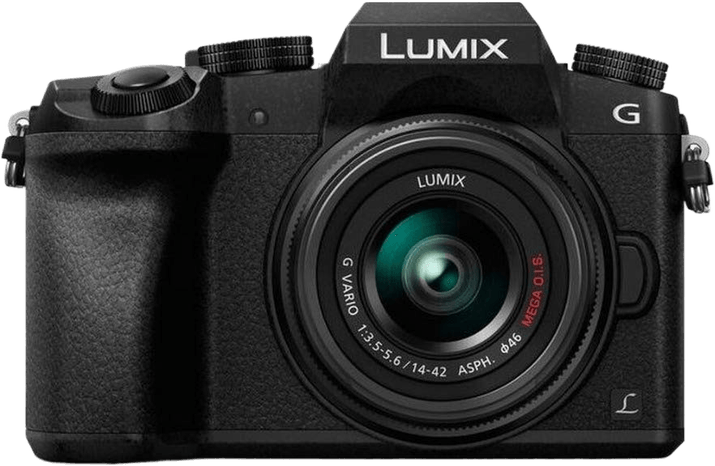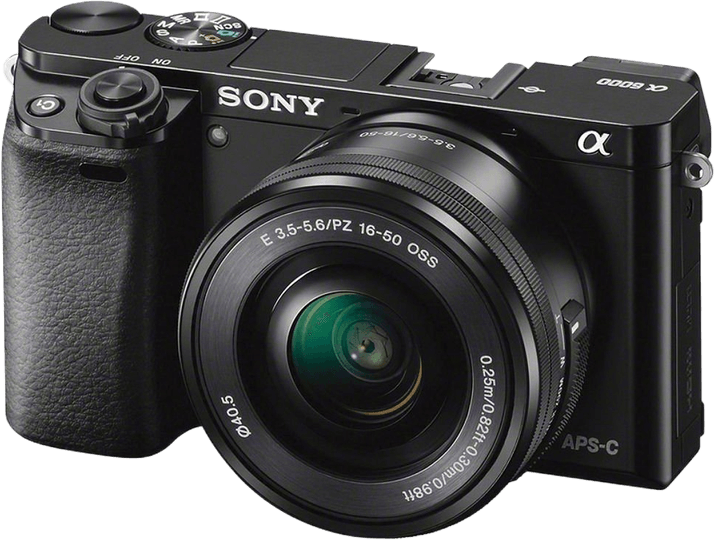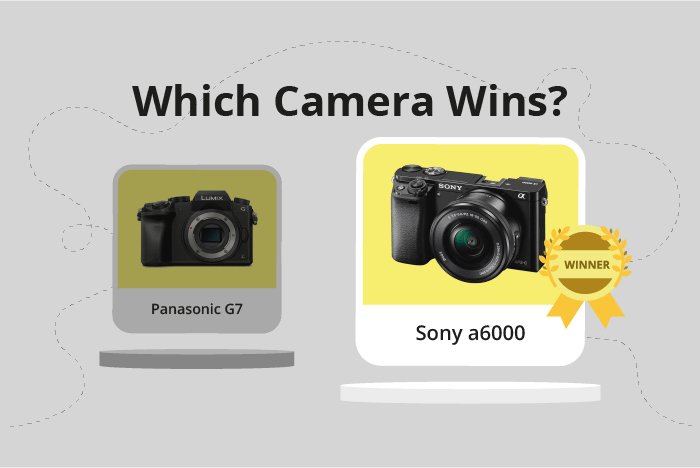Panasonic Lumix DMC-G7 vs Sony a6000 Comparison
Panasonic Lumix DMC-G7

Sony a6000

The Sony a6000 emerges as the winner with a score of 57/100, while the Panasonic Lumix DMC-G7 trails behind at 52/100. Both cameras share similarities, such as being mirrorless and having a launch price of $799. However, there are some differences that set them apart.
The Sony a6000 has a smaller size of 120 x 67 x 45mm and a lighter weight of 344g, making it more compact and portable than the Panasonic G7, which measures 125 x 86 x 77mm and weighs 410g. This size difference can be a significant factor for those who prioritize convenience and portability in a camera.
On the other hand, the Panasonic G7 holds some advantages over the Sony a6000, such as being a newer model, announced in 2015, while the Sony a6000 was announced in 2014. This factor may come into play if users prefer the most up-to-date technology.
Taking these factors into account, the Sony a6000’s compactness and portability give it an edge, while the Panasonic G7’s newer release date may appeal to those looking for more recent technology.
Panasonic Lumix DMC-G7 vs Sony a6000 Overview and Optics
The Sony a6000 outperforms the Panasonic Lumix DMC-G7 in optics, scoring 67/100 compared to the G7’s 51/100. Both cameras share several common specifications, including a CMOS sensor, lack of image stabilization, and similar aspect ratios (3:2 for the a6000 and 4:3 for the G7).
The Sony a6000 boasts a higher megapixel count at 24.3, compared to the G7’s 16 megapixels. This difference allows the a6000 to capture more detail and produce higher resolution images. Additionally, the a6000 has a faster shooting speed of 11 frames per second, compared to the G7’s 7 frames per second, making it more suitable for capturing fast-moving subjects. The a6000 also has a superior DXOMARK sensor score of 82 and a larger APS-C sensor, resulting in better image quality and low-light performance.
The Panasonic Lumix DMC-G7, on the other hand, possesses a Micro Four Thirds sensor and a Micro 4/3 lens mount. This combination offers a wider selection of lenses, providing greater flexibility for various shooting situations. However, this advantage does not compensate for the G7’s lower overall optics performance.
Taking these factors into account, the Sony a6000 proves to be superior in terms of optics due to its higher resolution, faster shooting speed, and better sensor performance. The Panasonic Lumix DMC-G7’s main advantage lies in its lens compatibility, but this is not enough to outweigh the a6000’s overall better performance.
Panasonic Lumix DMC-G7 vs Sony a6000 Video Performance
The Panasonic Lumix DMC-G7 outperforms the Sony a6000 in video capabilities, with a difference of 27 points in their video scores – 83/100 for the G7 and 56/100 for the a6000. Both cameras share some video features, such as the maximum video frame rate of 60fps. However, the G7 surpasses the a6000 in other aspects, contributing to its higher score.
The Lumix G7 has a superior maximum video resolution, offering 4K (3840 x 2160) compared to the a6000’s Full HD (1920 x 1080). This means that the G7 can capture finer details and produce higher quality video content. Additionally, the G7 has built-in time-lapse functionality, a feature not present in the a6000. This allows G7 users to easily create stunning time-lapse videos without needing external software or accessories.
On the other hand, the Sony a6000 does not have any specific advantages in its video capabilities over the Panasonic Lumix G7. Both cameras share the same maximum video frame rate, but the a6000 falls short in terms of resolution and time-lapse functionality. This makes the G7 a clear winner in video performance.
After comparing the video capabilities of these cameras, it is evident that the Panasonic Lumix DMC-G7 is the superior choice for those focused on video performance. Its 4K resolution and built-in time-lapse functionality provide users with the tools necessary for creating high-quality video content. The Sony a6000, while sharing some features with the G7, does not offer any advantages in video capabilities, making it a less suitable option for videographers.
Panasonic Lumix DMC-G7 vs Sony a6000 Features and Benefits
The Panasonic Lumix DMC-G7 outperforms the Sony a6000 in terms of features, with a score of 58 out of 100 compared to the Sony a6000’s 41 out of 100. Both cameras share several specs, such as a 3-inch screen size, flip screen, no GPS, WIFI connectivity, and no Bluetooth.
The Lumix G7 has a higher screen resolution of 2,360,000 dots, while the a6000 has a screen resolution of 921,600 dots. This higher resolution provides a clearer and more detailed display on the G7. Another advantage of the Lumix G7 is its touchscreen functionality, which the a6000 lacks. The touchscreen allows for easier navigation through menus and faster control over the camera settings.
On the other hand, the Sony a6000 has a few advantages over the Lumix G7. For example, it is generally more affordable than the G7, making it a more budget-friendly option for those who want a capable camera without breaking the bank.
In terms of features, the Panasonic Lumix DMC-G7 is the superior camera due to its higher screen resolution and touchscreen functionality. However, the Sony a6000 might be a better choice for those on a budget, as it is typically more affordable while still offering some comparable features. Ultimately, the decision between these two cameras will depend on an individual’s specific needs and priorities.
Panasonic Lumix DMC-G7 vs Sony a6000 Storage and Battery
The Panasonic Lumix DMC-G7 outperforms the Sony a6000 in storage and battery, scoring 35/100 compared to the Sony’s 21/100. Both cameras share similarities such as having a single memory card slot and accepting SD, SDHC, and SDXC cards.
The Lumix DMC-G7 has the advantage of USB charging, making it more convenient for users who need to charge their camera on the go. However, the a6000 has a slightly longer battery life, lasting 360 shots compared to the Lumix G7’s 350 shots. The Sony a6000 also accepts Memory Stick Pro Duo and Pro-HG Duo cards, offering more storage options.
Despite the a6000’s slightly longer battery life and additional storage compatibility, the Lumix DMC-G7 is the better choice due to its USB charging capability, which provides greater convenience for users.
Alternatives to the Panasonic Lumix DMC-G7 and Sony a6000
Are you still undecided about which camera is right for you? Have a look at these popular comparisons that feature the Panasonic Lumix DMC-G7 or the Sony a6000:

